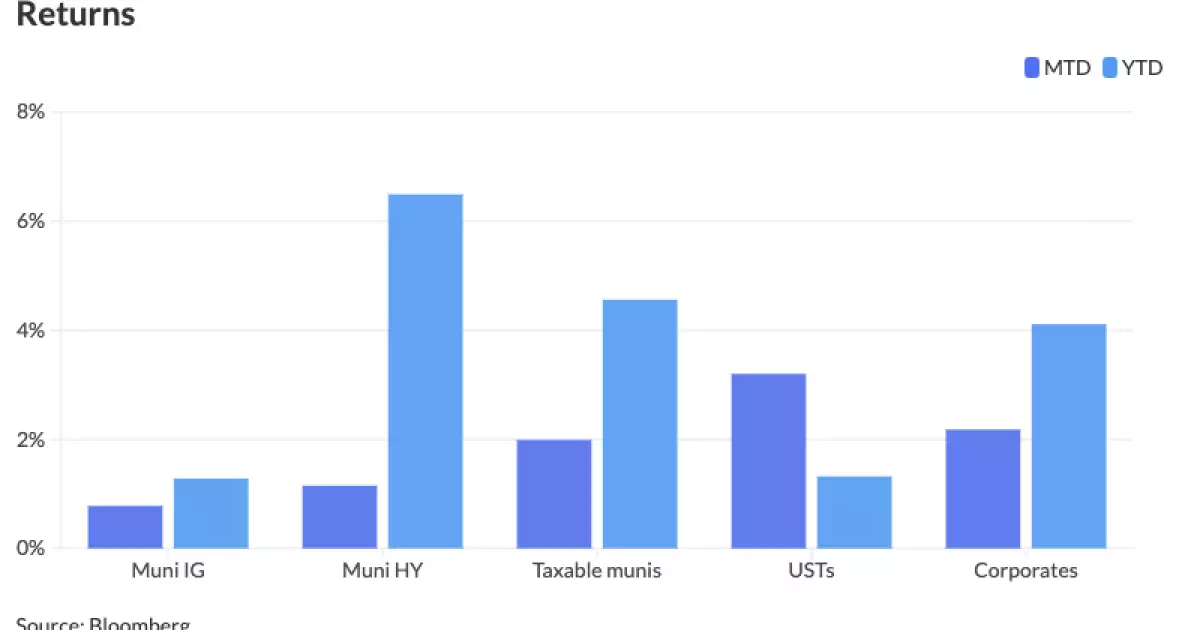The municipal bond market provides valuable insights into the economic conditions and investment patterns shaping the financial landscape. As we delve into the personnel dynamics and performance indicators observed in the latest reports, it becomes evident that various forces are influencing this segment in both positive and negative directions.
On what can be described as an uneventful Monday, municipal bonds exhibited a stable demeanor amidst a mixed performance from equities and a modest weakening in U.S. Treasuries. The pivotal muni-to-Treasury ratios portray a nuanced picture, with the two-year ratio standing at 62%, reflecting a cautious investor sentiment and an escalating reliance on municipal securities as a safe haven.
These figures indicate that investors are weighing their options carefully, as the slight variations in yields across various maturities signify an ongoing reassessment of risk versus return. Notably, the 30-year ratio peaked at 87%, highlighting a growing preference for long-term bonds, potentially fueled by uncertainties in the equity markets.
Contrasting the previous year, the municipal bond market has experienced a commendable rebound in August 2023, with returns at 0.78% compared to last year’s losses of 1.79%. This shift is particularly noteworthy given that it coincides with the Federal Reserve’s active stance on interest rates aimed at curbing high inflation. Jason Wong from AmeriVet Securities points out that the market is adjusting favorably earlier this year, hinting at a growing investor optimism.
With revenue costs rising by an average of 26 basis points across the curve in August, there have been noteworthy movements in individual sectors as well. For instance, 10-year notes have seen a 36 basis point increase, suggesting a reevaluation of medium-term projections. As markets react to Federal Reserve Chair Jerome Powell’s recent statements on rate cuts, it remains to be seen how this will subsequently impact long-term yields.
The quieter week preceding the Labor Day holiday illustrated a summer slowdown, with fewer market activities attributed to seasonal dynamics. Chris Brigati of SWBC observed that the market, especially on the longer end of the curve, was less reactive to movements in U.S. Treasuries, highlighting a more contained approach among investors.
Despite a dip in overall activity levels, the secondary market has shown signs of renewed interest. Catch-up trends have been noted, specifically as the ratios for 30-year munis reached nearly 90%, signaling a proactive engagement among buyers lining up for long-term investments.
As we look ahead, the forward calendar indicates an uptick in issuance, suggesting that the municipal market is positioned for activity, especially post-Labor Day. The $1.1 billion issuance from the North Texas Tollway Authority and the forthcoming $1.8 billion from the New York City Transitional Finance Authority underscore the competitive landscape forming in the coming weeks.
Furthermore, other notable deals, including a strategic $1.6 billion issuance slated for the District of Columbia, illustrate the various funding initiatives being taken by municipalities. The anticipation surrounding these issuances reflects an underlying confidence in municipal bonds as reliable long-term investments amid fluctuating economic conditions.
Current AAA scales reflect a stable yield environment, with marginal changes in the one through 30-year spectrum. As of recent readings, the one-year and two-year yields remain just above 2.5%, while the 10-year yield settles around 2.69%. This stability could appeal to risk-averse investors actively seeking consistency amidst broader market volatility.
While the municipal bond market displays signs of resilience and cautious optimism supported by favorable year-to-date performance, underlying challenges still loom. Investors are advised to keep a close watch on Fed policy changes, potential rate adjustments, and the broader macroeconomic factors that could impact municipal securities in both the short and long term. The balance between stability and volatility represents the delicate nature of this critical segment in the fixed-income landscape.

